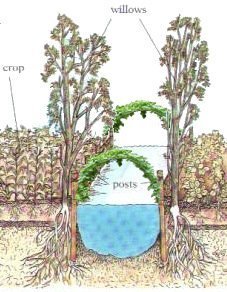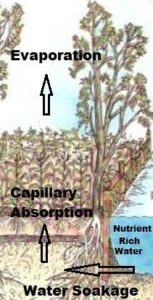What To Do With Swampy Land?
The Thunder Bay region is an area dotted with small lakes and extensive wetlands.
The natural inclination when faced with this type of terrain has historically been to simply drain it with a series of ditches.
Much of the land has been treated this way, and whole residential subdivisions are slowly sinking into the muskeg, due to the falling water table. Flood events are becoming more frequent due to the accelerated rate of water run-off because water regulating land features, such as wetlands, are being destroyed.
This mindset is so entrenched in the wider population, that many believe the only alternative to managing wetlands is to simply leave it to the mosquitoes and leeches.
This is not necessarily a bad thing. Wildlife needs their natural environments intact so that they can survive and thrive.
But is there another way? A way that creates an industrial scale food producing system, while at the same time benefit the natural ecology, maybe even enhancing the wetland diversity? Is it possible?
It turns out the answer to that question is yes.
Tenochtitlan was an ancient Aztec city located in what is now Mexico city. The area was originally a swamp (and today Mexico city, just like parts of Thunder Bay, is slowly sinking), and yet the city is believed to have supported a population of around 350,000 people.
A study of Tenochtitlan's agricultural systems reveals that they had one of the most efficient models of food production and distribution ever employed by humanity.
This model of food production is based on things called "Chinampas". A chinampa is basically a finger of artificially created solid ground separated by shallow canals.
A chinampa is constructed by driving stakes, or piles, into the wetland/ lake bed, and building a fence between them by weaving branches, reeds, etc to form something like a giant basket 30 meters long by 2.5 meters wide.
Mud is then excavated from the swamp / lake bed and placed inside these "baskets" until an area of dry land has been formed, and canals between them exist as a result of the excavation.
Once the land has been constructed, water loving trees, typically willows, are then planted along the banks to reinforce the fences, and annual crops planted in the isles.
Irrigation of the plants in such a system is extremely efficient, and works through the capillary action of water infiltrating the growing beds from the canals, and driven by the evaporative action of the plants themselves. The more water they need, the more water is supplied without any external input required by the farmer.
 In increase the productivity of the system further, trellis arches are constructed over the canals, unto which vining crops like cucumbers and melons are grown.
In increase the productivity of the system further, trellis arches are constructed over the canals, unto which vining crops like cucumbers and melons are grown. These have the added benefit of providing shade over the water, and creating a suitable environment for raising fish.
Aquatic fowl, like ducks and geese are then added into the system and feed of aquatic plants and insects that live within this diverse ecosystem.
The fish and fowl defecate in the water, and the subsequent nutrients are taken up by the crops as part of the previously described irrigation mechanism.
By all accounts, this system takes aquaponics, and applies it on an industrial scale that is simply not economically feasible using our modern technological approach.
By all accounts, this system takes aquaponics, and applies it on an industrial scale that is simply not economically feasible using our modern technological approach.
The elimination of the need to fertilise and irrigate crops means that the energy required to maintain such a system is considerably reduced, and human effort can be focussed on the task of harvesting and distributing the harvest.
 Harvesting
Harvesting
History has proven that by far the most efficient way to transport goods is via boat. The same principle applies to harvesting and transporting produce.
The reason for this is that the carrying capacity of a boat is very high in comparison to the energy required to move it.
The canals within a chinampa system adhere to the permaculture principle of stacking as many functions as possible within a component of a design system.
In this case, the canal serves as:
The reason for this is that the carrying capacity of a boat is very high in comparison to the energy required to move it.
The canals within a chinampa system adhere to the permaculture principle of stacking as many functions as possible within a component of a design system.
In this case, the canal serves as:
- Irrigation
- Nutrient Transport
- Food Growing Medium (Fish etc)
- Harvesting Conduits
Cold Climate Adaptation
The traditional climate for this agricultural system is sub tropical wetland, so there as some factors that need to me taken into account when applying it to a zone 3 environment as we have here in Thunder Bay.
The most obvious factor is the effect of winter ice and snow on the system, and how this influences suitable plant and animal species.
An advantage of a winter freeze on a chinampa system is the ability to access the growing areas using land based machinery via a way of miniature "ice roads" formed by the frozen canals.
The seasonal glaciation events within the growing areas caused by frost heave introduce an additional mechanism that aids in soil aeration. This action has not been observed in a working chinampa system, and so further research on it's effects could lead to some very interesting findings.
Suitable perennial species of trees and shrubs needs to be identified. The traditional willow that is utilised to reinforce the banks can still be used if a cold hardy species is selected. However, a permaculturist is looking to stack functions...
For bank stabilisation and fruit production, pears seem to be an appropriate alternative due to their moisture loving roots and inclination to grow well on river banks. They're also suited to our climate. Although they produce an edible crop, pears do not float, which means that any fruit that falls into the canal will be recycled back into the system as nutrients.
Apples are another option for over story food production and bank stabilisation provided that the correct variety is selected for moisture tolerance. Apples also float, and the trees can be trained to form living trellises (see espalier) over the canals onto which vining crops, like cranberry, hops, grapes, and melons can then be grown.
Cranberries will grow in this climate, and its vining habit means that it can be trained onto trellises over the canals.
This makes the additional task of harvesting simple because the fruit floats, and can be simply knocked off the vines into the canal.
The most obvious factor is the effect of winter ice and snow on the system, and how this influences suitable plant and animal species.
An advantage of a winter freeze on a chinampa system is the ability to access the growing areas using land based machinery via a way of miniature "ice roads" formed by the frozen canals.
The seasonal glaciation events within the growing areas caused by frost heave introduce an additional mechanism that aids in soil aeration. This action has not been observed in a working chinampa system, and so further research on it's effects could lead to some very interesting findings.
Suitable perennial species of trees and shrubs needs to be identified. The traditional willow that is utilised to reinforce the banks can still be used if a cold hardy species is selected. However, a permaculturist is looking to stack functions...
For bank stabilisation and fruit production, pears seem to be an appropriate alternative due to their moisture loving roots and inclination to grow well on river banks. They're also suited to our climate. Although they produce an edible crop, pears do not float, which means that any fruit that falls into the canal will be recycled back into the system as nutrients.
Apples are another option for over story food production and bank stabilisation provided that the correct variety is selected for moisture tolerance. Apples also float, and the trees can be trained to form living trellises (see espalier) over the canals onto which vining crops, like cranberry, hops, grapes, and melons can then be grown.
Cranberries will grow in this climate, and its vining habit means that it can be trained onto trellises over the canals.
This makes the additional task of harvesting simple because the fruit floats, and can be simply knocked off the vines into the canal.
Something to take note of is that hazelnuts also float, and the shrub grows well on canal banks. It is also an excellent coppicing wood and provider of spring bee forage.
Appropriate Nitrogen fixing support species suitable for stabilising the canal banks include seabuckthorn, which produce an edible crop amongst many other functional attributes.
Blue False Indigo is a perennial under-story Nitrogen fixer suited to river bank environments which is loved by bees and can be heavily and repeatedly chopped and dropped.
Lupines are an annual under-story Nitrogen fixing plant also loved by bees, although it doesn't seem to tolerate shade as well as blue false indigo.
 |
| Bees love blue false indigo |
Cold Climate Examples
There is unfortunately very little information available regarding cold climate chinampa implementations in cold climates.
Rick Larson has a working demonstration in Wisconsin where he is growing wild rice and blueberries.
This video below is in a zone 5 climate, located in Montana:
Rick had some neat videos of his chanampa project but have since been pulled from Youtube. Maybe he will put them up again one day...
Final Thoughts
Traditional chinampa involve the creation of annual crop growing beds separated by canals whose banks are stabilised with willow trees.
A modern, cold climate permaculture implementation involves the use of food producing and Nitrogen fixing trees for bank stabilisation and wind breaks. The incorporation of aquaculture, animal systems, and vertical stacking boost the productive capacity of traditional annual crops.
Something to consider with regards to the annual crops is the incorporation of Hugelkultur as a way to increase productivity, diversity, and edge zones to the system.
Thunder Bay has an abundance of windfall trees thanks to the abundant, fast growing, shallow rooted, and short lived black spruce, which makes for great hugelkultur building material.
Raising crops up off the water table in this way also provides an opportunity to grow plants that prefer dryer conditions than would otherwise prevail.
Additionally, the physical barrier to the effects of wind would create warm, humid micro-climates, and offer the potential to extend the growing season.
The soggy back forty on many Thunder Bay farms has the very real potential to produce food in both diversity and scale, that far exceeds the capacity of what is commonly considered prime acreage.
Furthermore, the water holding and run-off regulating characteristics are preserved.
Once these areas are developed, they provide a sophisticated wetland ecosystem incorporating far more species of wildlife than the previous environment was capable of doing.







Great article, great ideas! Thank you,
ReplyDelete